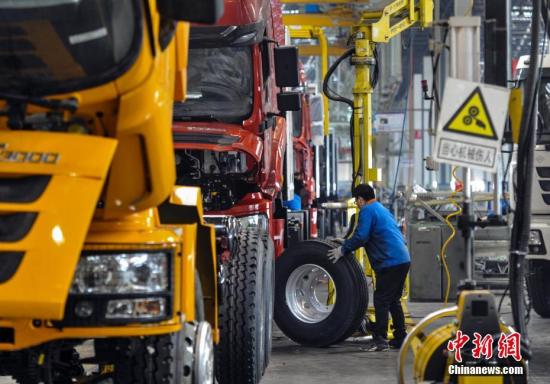(Countering new crown pneumonia) China's economic war "epidemic" record: core enterprises accelerate the resumption of labor
China News Agency, Beijing, March 19th, title: "Epilepsy" record of China's economic war: core enterprises accelerate the resumption of work, and Chinese manufacturing efforts regain vitality
China News Agency reporter Liu Yuying
The resumption rate of labor in many places in China exceeds 90%, the recovery of the industrial chain is accelerating, and Chinese manufacturing is striving to regain vitality.
On March 3, the assembly workshop of Shaanxi Xinjiang Automobile Co., Ltd., located in the Economic and Technological Development Zone (Toutunhe District) of Urumqi, Xinjiang, is stepping up production. China News Agency reporter Liu Xinshe
Accelerating the recovery of the industrial chain
At present, the resumption of production and production of industrial enterprises above designated size in China is close to normal levels. According to statistics from the Ministry of Industry and Information Technology of China, as of March 17, the average operating rate of industrial enterprises above designated size in the country except Hubei has exceeded 98%, and the average rate of reinstatement of enterprise personnel is approximately 84.8%.
The resumption of work by core enterprises can drive the entire industry chain to work. In Hunan, Zoomlion and Sany Heavy Industry, the leading companies in the construction machinery industry, are close to full production. In February, the output of Sany Heavy Industry increased sharply, a 50% increase over January. SANY also helped upstream and downstream enterprises resume production.
Large enterprises are now returning to work faster than SMEs. The Ministry of Industry and Information Technology organized industry associations and experts to sort out and arrange more than 50 backbone enterprises and more than 7,000 core supporting small and medium-sized enterprises on multiple industrial chains to solve the problems of raw materials, funds, and personnel of supporting enterprises.
By March 10, Zhejiang Province has promoted a total of 2,360 supporting enterprises to resume production, and 870 supporting enterprises in 16 brother provinces and cities have successfully resumed production and production.
Hubei is an important manufacturing base for automobiles, electronics, and optical communications. The supporting companies of Volkswagen, BMW, Hyundai and some domestic auto companies are all located in Hubei. As of March 17, 7629 industrial enterprises above designated size in Hubei have resumed work and resumed production, with a return rate of 49.3%.
Xin Guobin, deputy minister of the Ministry of Industry and Information Technology, said that Dongfeng Motor Group's factories in Shiyan and Xiangfan have resumed production, and Dongfeng Honda and Dongfeng passenger car factories in Wuhan have also resumed production, which has played an important role in stabilizing the global supply chain.
"Breakpoints" and "blocking points" gradually get through
At the beginning of the resumption of work, it was difficult to return to work, prevent epidemics, transport, and recruit workers ... By clearing a series of blocking points, Chinese factories have gradually entered the right track.
At the end of February, the Ministry of Industry and Information Technology sent liaison officers to resume work and resume production in seven provinces including Hunan and Sichuan. The reporter learned from the seventh group of liaison officers who resumed work and resumed production in Hunan that the problems found during the investigation were coordinated and resolved through different levels of paths.
It is understood that most of the outstanding issues have been alleviated. For example, the prevention and control of material problems in resumption enterprises is ensured by the provinces through intra-provincial scheduling. In Hunan, by the end of February, the problem of tight control materials had eased.
It is difficult for personnel to rework, and it is solved by charter, charter and special train. By March 9, Zhejiang received 807,000 migrant workers through these methods. China's five departments have made it clear that for migrant workers who return to work by these methods, there are no symptoms and they need not be quarantined 14 days before their departure.
Transportation difficulties. With the opening of road checkpoints in various places, traffic has accelerated to resume. However, some places require the driver to be isolated for 14 days after arriving at the destination, and there are still trucks returning empty due to insufficient demand, resulting in high freight costs.
For the problems that are difficult to be solved by a single department, a special class of industry chain coordination, resumption and production, led by the Ministry of Industry and Information Technology and involving multiple departments such as finance, finance, and transportation, is set up to coordinate and solve cross-department and cross-region problems.
Uncertainty still exists
China's manufacturing industry chain has started to return to normal, but the risk of epidemics from abroad is increasing.
If the foreign epidemic continues to spread, Chinese manufacturing will face some parts supply and demand issues. Xin Guobin said that if the time is longer, it will have a certain impact on China. However, he believes that China is the country with the largest industry scale, the most complete categories and the largest domestic market demand, and this kind of influence is manageable.
SMEs are also in a difficult situation. A survey of small and medium-sized enterprises organized by the Economic and Information Bureau of Deyang City, Sichuan Province showed that 92.08% of enterprises said that their operating income was reduced and liquidity was tight, and 34.6% of them said they were unable to repay debts such as loans in a timely manner and increased pressure on funds.
It is understood that during the epidemic, due to the lack of collateral and low bank credit, it is difficult for SMEs to enjoy bank loan support. China's official measures have been adopted to solve the financing problems of small and medium-sized enterprises, including targeted reduction of standards, and support for orders and accounts receivables as collateral. However, the difficulty of financing small and medium-sized enterprises is a long-term problem, and it will take time to resolve them. (Finish)

